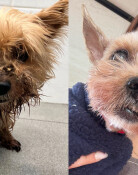[Opinion] The Horror of Chinese-made Food
[Opinion] The Horror of Chinese-made Food
Posted September. 23, 2008 03:13,
A Chinese in Henan province became suspicious after tasting a fried egg from a street vendor, and pressed the seller to disclose the secret of making fake eggs. The whites of an egg are made from sodium alginate, which is used by the food industry to increase viscosity. For egg yolk, lemon yellow coloring powder is mixed with egg whites. The liquid is mixed with calcium chloride solution, which gives the yolk a thin outer membrane and firms it up. Counterfeit beef made of cheap ham and flour was found to be distributed in Jiangsu province.
Methods of making fake food products in China go beyond the outrageous. In China, wines whose ingredients do not contain grapes are sold cheaper than water. It is said brand liquor or expensive tea at Chinese duty-free shops at airports or swanky hotels cannot be trusted. This year alone, 11 Chinese died in Guangdong province after drinking fake liquor tainted with methanol. Chinese authorities impose felony charges on fake food manufactures after global media were in an uproar over pesticide-tainted Chinese dumplings. Despite such efforts, however, the end of the fake food crisis seems elusive.
Chinas food safety crisis widened across the world after melamine was found in powdered milk. The number of infants who died or were sickened by the tainted milk has reached about 40,000. Unlike Beijings previous announcement, contaminated baby formulas were exported to countries in South Asia and Africa. Chocolate products and confectionery using the baby formula were also found to have been exported to Korea and Japan and feed containing melamine were also supplied to Korean fisheries. As more people are growing nervous and angry over the debacle, the Korean Food and Drug Administration will conduct additional tests for melamine on all Chinese processed foods, along with Chinese powdered milk.
The instances of tainted Chinese food are too many to count. They include eels contaminated with malachite green, lead-tainted crabs, heavy metal contamination in teas, black sesame seeds dyed with synthetic pigments, and bleached steamed rice. According to a report by the drug administration, the amount of Chinese food disposed after being found contaminated with carcinogens and germs is 40 tons. We cannot but wonder why candlelight protesters in Korea have remained silent over tainted Chinese food when they angrily took to the streets over unfounded rumors of U.S. beef.
Editorial Writer Chung Sung-hee (shchung@donga.com)





![쓸개 파열로 “사흘 남았다” 판정받은 시인…18년뒤 “너를 아껴라” 속삭여[손효림의 베스트셀러 레시피]](https://dimg.donga.com/c/138/175/90/1/wps/NEWS/IMAGE/2026/01/08/133113134.1.jpg)

